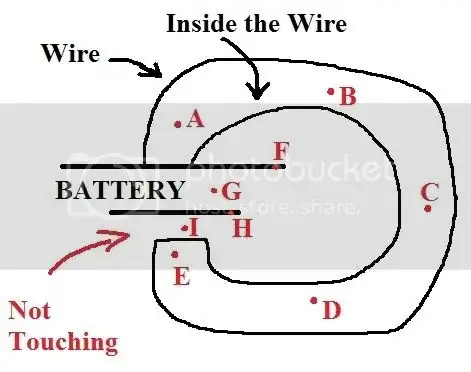I think the electric field is zero on A, B, C, D and E, because otherwise there would be current, which would be odd
And you are totally right for an electrostatic system (with no current). Instead of explaining it by, "this would be odd", let's have a look at what happens in the instant you add the wire to the battery pole.:
- Before the wire touches the pole, electrons are spread evenly in the wire.
- At the instant the wire touches, suddenly the large negative charge at the pole repels the electrons. They move towards the other end. By now there is and electric field $E=\frac{F}{q}$, caused by the battery to move the electrons
- After a very short time enough electrons have moved to the other end. Now they repel each other just as much as the repulsion from the pole. In other words, an equal electric field has been set up in the other end cancelling the battery's field. The net field at all points is now zero, and everything is still (electrostatic).
I also think the electric potential is constant at those points
Also true. It's like putting two balls on the same shelf. They will not roll around on this shelv; they would only roll if one shelf was lower than the other. For the charges, there is only an electric potential if they "want to move there".
So with reference to point E or D or C or any other point within the wire, there is no electric potential, since no area has less repulsion than another area. If that would have been the case, it would very quickly be evened out by electrons moving around until that potential has been used up (like the balls rolling until they are as far down as possible, lowering the potential as much as possible.)
I have no clue for the other points though.
If the wire end is very close to an area of lower potential, which seems to be the case, then this acts like a capacitor. The electric field in between the capacitor plates is non-zero. Put a charge there and it will be simultaneously repelled from one side and attracted to the other, and will move. This is the case for point I.
About point G. It is just as for point I, so it depends on the distance between the two plates. But as you say, those plates are in reality a battery and not simply two seperated poles. If point G is inside the battery, then it might experience the so called electromotive force. This is the work done by the battery on the charges at the lower pole to bring them back to the upper pole, ready to move again through the circuit. This is a "potential" in the sense that they are added energy. G must be very specifically located to say anymore though.
and I know the electric field in F and H are undefined (this is a controversial thing, I want to avoid that, I don't care for the electric field on F and H)
Interesting, if you have a link, please provide it :)
